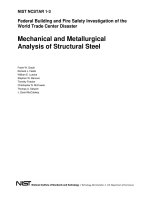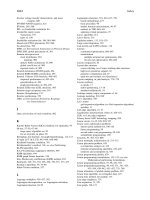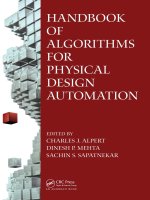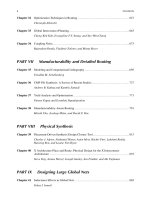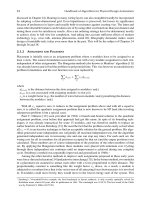Handbook of Structural Steel Connection Design and Details
Bạn đang xem bản rút gọn của tài liệu. Xem và tải ngay bản đầy đủ của tài liệu tại đây (48.64 MB, 652 trang )
Copyright©2017byMcGraw-HillEducation.Allrightsreserved.Exceptaspermittedunder
theUnitedStatesCopyrightActof1976,nopartofthispublicationmaybereproducedor
distributedinanyformorbyanymeans,orstoredinadatabaseorretrievalsystem,without
thepriorwrittenpermissionofthepublisher.
ISBN:978-1-25-958552-4
MHID:1-25-958552-2
ThematerialinthiseBookalsoappearsintheprintversionofthistitle:ISBN:978-1-25958551-7,MHID:1-25-958551-4.
eBookconversionbycodeMantra
Version1.0
Alltrademarksaretrademarksoftheirrespectiveowners.Ratherthanputatrademarksymbol
aftereveryoccurrenceofatrademarkedname,weusenamesinaneditorialfashiononly,and
tothebenefitofthetrademarkowner,withnointentionofinfringementofthetrademark.
Wheresuchdesignationsappearinthisbook,theyhavebeenprintedwithinitialcaps.
McGraw-HillEducationeBooksareavailableatspecialquantitydiscountstouseaspremiums
andsalespromotionsorforuseincorporatetrainingprograms.Tocontactarepresentative,
pleasevisittheContactUspageatwww.mhprofessional.com.
InformationcontainedinthisworkhasbeenobtainedbyTheMcGraw-HillCompanies,Inc.
(“McGraw-Hill”)fromsourcesbelievedtobereliable.However,neitherMcGraw-Hillnorits
authorsguaranteetheaccuracyorcompletenessofanyinformationpublishedherein,and
neitherMcGraw-Hillnoritsauthorsshallberesponsibleforanyerrors,omissions,or
damagesarisingoutofuseofthisinformation.Thisworkispublishedwiththeunderstanding
thatMcGraw-Hillanditsauthorsaresupplyinginformationbutarenotattemptingtorender
engineeringorotherprofessionalservices.Ifsuchservicesarerequired,theassistanceofan
appropriateprofessionalshouldbesought.
TERMSOFUSE
ThisisacopyrightedworkandMcGraw-HillEducationanditslicensorsreserveallrightsin
andtothework.Useofthisworkissubjecttotheseterms.Exceptaspermittedunderthe
CopyrightActof1976andtherighttostoreandretrieveonecopyofthework,youmaynot
decompile,disassemble,reverseengineer,reproduce,modify,createderivativeworksbased
upon,transmit,distribute,disseminate,sell,publishorsublicensetheworkoranypartofit
withoutMcGraw-HillEducation’spriorconsent.Youmayusetheworkforyourown
noncommercialandpersonaluse;anyotheruseoftheworkisstrictlyprohibited.Yourright
tousetheworkmaybeterminatedifyoufailtocomplywiththeseterms.
THEWORKISPROVIDED“ASIS.”McGRAW-HILLEDUCATIONANDITSLICENSORS
MAKENOGUARANTEESORWARRANTIESASTOTHEACCURACY,ADEQUACYOR
COMPLETENESSOFORRESULTSTOBEOBTAINEDFROMUSINGTHEWORK,
INCLUDINGANYINFORMATIONTHATCANBEACCESSEDTHROUGHTHEWORK
VIAHYPERLINKOROTHERWISE,ANDEXPRESSLYDISCLAIMANYWARRANTY,
EXPRESSORIMPLIED,INCLUDINGBUTNOTLIMITEDTOIMPLIEDWARRANTIES
OFMERCHANTABILITYORFITNESSFORAPARTICULARPURPOSE.McGraw-Hill
Educationanditslicensorsdonotwarrantorguaranteethatthefunctionscontainedinthe
workwillmeetyourrequirementsorthatitsoperationwillbeuninterruptedorerrorfree.
NeitherMcGraw-HillEducationnoritslicensorsshallbeliabletoyouoranyoneelseforany
inaccuracy,errororomission,regardlessofcause,intheworkorforanydamagesresulting
therefrom.McGraw-HillEducationhasnoresponsibilityforthecontentofanyinformation
accessedthroughthework.UndernocircumstancesshallMcGraw-HillEducationand/orits
licensorsbeliableforanyindirect,incidental,special,punitive,consequentialorsimilar
damagesthatresultfromtheuseoforinabilitytousethework,evenifanyofthemhasbeen
advisedofthepossibilityofsuchdamages.Thislimitationofliabilityshallapplytoanyclaim
orcausewhatsoeverwhethersuchclaimorcausearisesincontract,tortorotherwise.
CONTENTS
Contributors
PrefacetotheThirdEdition
PrefacetotheFirstEdition
Acknowledgments
Chapter1.FastenersandWeldsforStructuralConnectionsLarryS.Muir,P.E.,William
A.Thornton,Ph.D.,P.E.,andThomasKane,C.Eng.,M.I.Struct.E.
1.1Introduction
1.2BoltedConnections
1.2.1TypesofBolts
1.2.2WasherRequirements
1.2.3PretensionedandSnug-TightBolts
1.2.4Bearing-TypeversusSlip-CriticalJoints
1.2.5BoltsinCombinationwithWelds
1.2.6Standard,Oversized,Short-Slotted,andLong-SlottedHoles
1.2.7EdgeDistancesandSpacingofBolts
1.2.8Installation
1.3WeldedConnections
1.3.1TypesofWelds
1.3.2WeldingSymbols
1.3.3WeldingMaterial
1.3.4WeldingPositions
1.3.5WeldProcedures
1.3.6WeldQuality
1.3.7MethodsforDeterminingStrengthofSkewedFilletWelds
1.3.8ObliquelyLoadedConcentricFilletWeldGroups
References
Chapter2.DesignofConnectionsforAxial,Moment,andShearForcesLarryS.Muir,
P.E.,WilliamA.Thornton,Ph.D.,P.E.,andThomasKane,C.Eng.,M.I.Struct.E.
2.1Introduction
2.1.1Philosophy
2.1.2GeneralProcedure
2.1.3EconomicConsiderations
2.1.4TypesofConnections
2.1.5Organization
2.2AxialForceConnections
2.2.1BracingConnections
2.2.2TrussConnections
2.2.3HangerConnections
2.2.4ColumnBasePlates
2.2.5Splices—ColumnsandTrussChords
2.3MomentConnections
2.3.1Introduction
2.3.2Example:Three-WayMomentConnection
2.4ShearConnections
2.4.1Introduction
2.4.2FramedConnections
2.4.3SkewedConnections
2.4.4SeatedConnections
2.4.5BeamShearSplices
2.4.6ExtendedSingle-PlateShearConnections(ShearTabs)
2.5MiscellaneousConnections
2.5.1SimpleBeamConnectionsunderShearandAxialLoad
2.5.2ReinforcementofAxialForceConnections
2.5.3ExtendedTabwithAxial
References
Chapter3.WeldedJointDesignandProductionDuaneK.Miller,Sc.D.,P.E.,and
MichaelD.Florczykowski
3.1Introduction
3.2WeldingCodesandStandards
3.2.1AISCSpecifications
3.2.2AWSSpecifications
3.3StructuralSteelsforWeldedConstruction
3.3.1AWSD1.1SteelListings
3.3.2AISCSpecificationTreatmentofUnidentifiedSteels
3.3.3WeldingRequirementsforSpecificSteels
3.4WeldingandThermalCuttingProcesses
3.4.1ShieldedMetalArcWelding
3.4.2FluxCoredArcWelding
3.4.3GasMetalArcWelding
3.4.4SubmergedArcWelding
3.4.5GasTungstenArcWelding
3.4.6ArcStudWelding
3.4.7ElectroslagWelding
3.4.8OxyfuelCutting
3.4.9PlasmaArcCutting
3.4.10AirCarbonArcCuttingandGouging
3.5WeldedJointDesign
3.5.1CJPGrooveWelds
3.5.2PJPGrooveWelds
3.5.3FilletWelds
3.6WeldingProcedures
3.6.1EffectsofWeldingVariables
3.6.2PurposeofWeldingProcedureSpecifications
3.6.3PrequalifiedWeldingProcedureSpecifications
3.6.4GuidelinesforPreparingPrequalifiedWPSs
3.6.5QualifyingWeldingProceduresbyTest
3.6.6ApprovalofWPSs
3.7WeldingCostAnalysis
3.8WeldingProblems:CrackingandTearingduringFabrication
3.8.1CenterlineCracking
3.8.2UnderbeadCracks
3.8.3TransverseCracks
3.8.4LamellarTearing
3.9WeldingProblems:Distortion
3.10WeldingonExistingStructures
3.10.1SafetyPrecautions
3.10.2ExistingSteelCompositionandCondition
3.10.3WeldingandCuttingonMembersunderLoad
3.10.4ModificationsandAdditionstoUndamagedSteel
3.10.5RepairofPlasticallyDeformedSteel
3.11WeldingonSeismicallyResistantStructures
3.11.1HighConnectionDemands
3.11.2StressConcentrations
3.11.3FractureResistance
3.11.4DemandCriticalConnectionsandProtectedZones
3.11.5SeismicWeldedConnectionDetails
3.11.6FillerMetalRequirements
3.11.7WelderQualificationTests
3.11.8NondestructiveTesting
3.12Acknowledgments
References
Chapter4.PartiallyRestrainedConnectionsRobertoT.Leon
4.1Introduction
4.2ConnectionClassification
4.2.1ConnectionStiffness
4.2.2ConnectionStrength
4.2.3ConnectionDuctility
4.2.4DerivationofM-θCurves
4.2.5Analysis
4.3DesignofBoltedPRConnections
4.3.1ColumnWelded-BeamBoltedConnections
4.3.2ColumnBolted-BeamBolted(TStubs)
4.3.3End-PlateConnections
4.4FlexiblePRConnections
4.5ConsiderationsforAnalysisofPRFrames
References
Chapter5.SeismicDesignofConnectionsJamesO.MalleyandRaymondS.Pugliesi
5.1SpecialDesignIssuesforSeismicDesign
5.2ConnectionDesignRequirementsforVariousStructuralSystems
5.3DesignofSpecialMoment-FrameConnections
5.3.1Introduction
5.3.2Post-NorthridgeDevelopmentsinConnectionDesign
5.3.3ToughenedConnections
5.3.4StrengthenedConnections
5.3.5WeakenedConnections
5.4ConcentricallyBracedFrames
5.4.1Introduction
5.4.2ConnectionDesignandExample
5.5EccentricallyBracedFrames
5.6BucklingRestrainedBracedFrames
5.7SpecialPlateShearWalls
5.8OtherConnectionsinSeismicFrames
References
Chapter6.StructuralSteelDetailsDavidR.Williams,P.E.
Reference
Chapter7.ConnectionDesignforSpecialStructuresLawrenceA.Kloiber
7.1Introduction
7.2LateralLoadSystems
7.3Long-SpanTrusses
7.4Space-FrameStructures
7.5ExamplesofConnectionsforSpecialStructures
7.6BuildingInformationModel
7.7Conclusion
References
Chapter8.QualityControlandQualityAssuranceRobertE.Shaw,Jr.,P.E.
8.1PrinciplesofQualityControlandQualityAssurance
8.2StandardsforQCandQA
8.3Fabricator ’sandErector ’sQCPrograms
8.3.1FabricatorandErectorQCActivities
8.3.2QCInspectionPersonnel
8.3.3FabricatorandErectorApprovals
8.4QualityAssurancePrograms
8.4.1QAInspectionActivities
8.4.2QAInspectionPersonnel
8.4.3NondestructiveTestingPersonnel
8.5InspectionofBoltedConnections
8.5.1ScopeofInspections
8.5.2InspectionpriortoBolting
8.5.3InspectionduringBolting
8.5.4InspectionafterBolting
8.6InspectionofWeldedConnections
8.6.1AdvanceInspection
8.6.2InspectionpriortoWelding
8.6.3InspectionduringWelding
8.6.4InspectionafterWelding
8.6.5NondestructiveTesting
8.6.6WeldAcceptanceCriteria
Chapter9.SteelDeckConnectionsThomasSputo,Ph.D.,P.E.,S.E.,RichardB.Heagler,
P.E.,andJohnMattingly
Chapter10.ConnectionstoCompositeMembersAtorodAzizinamini,Ph.D.,P.E.,
BahramShahrooz,Ph.D.,AhmedEl-Remaily,Ph.D.,P.E.,andHassanAstaneh,Ph.D.,P.E.
10.1Introduction
10.2GeneralDesignConsiderations
10.2.1StrengthandStiffness
10.2.2Stability
10.2.3Serviceability
10.2.4CyclicBehavior
10.3Beam-to-WallConnections
10.3.1IntroductoryRemarks
10.3.2QualitativeDiscussionAboutOutriggerBeam-WallConnectionandCoupling
Beam-WallConnection
10.3.3DesignofSteelorSteel-ConcreteCompositeCouplingBeam-WallConnections
10.3.4DesignofOutriggerBeam-WallConnections
10.4JointsBetweenSteelBeamsandReinforcedConcreteColumns
10.4.1Introduction
10.4.2JointBehavior
10.4.3JointDetailing
10.4.4JointForces
10.4.5EffectiveJointWidth
10.4.6StrengthRequirements
10.4.7Limitations
10.5ConnectionstoConcrete-FilledTube(CFT)Columns
10.5.1Introduction
10.5.2CurrentPractice
10.5.3ProblemsAssociatedwithWeldingBeamstoCFTColumns
10.5.4PossibleConnectionDetail
10.5.5ForceTransferMechanismforThrough-BeamConnectionDetail
10.5.6TentativeDesignProvisionsforThrough-BeamConnectionDetail
10.6Notations(ForSec.10.3)
References
AppendixA.StructuralShapes—DimensionsandGeneralInformation
AppendixB.WeldingSymbols
AppendixC.SIMetricConversionTable
AppendixD.Nomenclature
Index
CONTRIBUTORS
HassanAstaneh,Ph.D.,P.E.Professor,DepartmentofCivilEngineering,Universityof
California,Berkeley,California(Chap.10)
AtorodAzizinamini,Ph.D.,P.E.Professor,CivilEngineeringDepartment,Universityof
Nebraska,Lincoln,Nebraska,andNationalBridgeResearchOrganization(NaBRO),
UniversityofNebraska,Lincoln,Nebraska(Chap.10)
AhmedEl-Remaily,Ph.D.,P.E.UniversityofNebraska,Lincoln,Nebraska(Chap.10)
MichaelD.Florczykowski,TheLincolnElectricCompany,Cleveland,Ohio(Chap.3)
RichardB.Heagler,P.E.Retired;formerly,NicholasJ.Bouras,Inc.,MurrayHill,New
Jersey(Chap.9)
ThomasKane,C.Eng.,M.I.Struct.E.Retired;formerly,TechnicalManager,CivesSteel
Company,Roswell,Georgia(Chaps.1,2)
LawrenceA.KloiberLeJeuneSteel,Minneapolis,Minnesota(Chap.7)
RobertoT.LeonD.H.BurrowsProfessorofConstructionEngineering,ViaDepartmentof
CivilandEnvironmentalEngineering,VirginiaTech,Blacksburg,Virginia(Chap.4)
JamesO.MalleySeniorPrincipal,DegenkolbEngineers,SanFrancisco,California(Chap.
5)
JohnMattinglyRetired;formerly,CMCJoist&Deck,MurrayHill,NewJersey(Chap.9)
DuaneK.Miller,Sc.D.,P.E.TheLincolnElectricCompany,Cleveland,Ohio(Chap.3)
LarryS.Muir,P.E.DirectorofTechnicalAssistance,AmericanInstituteofSteel
Construction,Atlanta,Georgia(Chaps.1,2)
RaymondS.PugliesiPrincipal,DegenkolbEngineers,SanFrancisco,California(Chap.5)
BahramShahrooz,Ph.D.Professor,CivilEngineeringDepartment,Universityof
Cincinnati,Cincinnati,Ohio(Chap.10)
RobertE.Shaw,Jr.,P.E.President,SteelStructuresTechnologyCenter,Inc.,Howell,
Michigan(Chap.8)
ThomasSputo,Ph.D.,P.E.,S.E.TechnicalDirector,SteelDeckInstitute,Gainesville,
Florida(Chap.9)
AkbarR.Tamboli,P.E.F.ASCEConsultant,ThorntonTomasetti,Newark,NewJersey
(Apps.A,B,C,D)
WilliamA.Thornton,Ph.D.,P.E.CorporateConsultant,CivesSteelCompany,Roswell,
Georgia(Chaps.1,2)
DavidR.Williams,P.E.Principal,WilliamsEngineeringAssociates,VirginiaBeach,
Virginia(Chap.6)
ABOUTTHEEDITOR
AkbarR.Tamboli,P.E.,F.ASCE,isaconsultantatThorntonTomasettiinNewYork.Hehas
beenaseniorprojectengineerwithCUH2AinPrinceton,NewJersey,acompanythat
specializedinarchitecture,engineering,andplanning.Hehasalsobeenavicepresidentand
projectmanageratCantor-SeinukGroupPC,ConsultingEngineers,inNewYork,wherehe
wastheprincipalconsultingengineeronanumberofnoteworthyprojects,includingMorgan
GuarantyBankHeadquartersat60WallStreetandSalomonBrothersWorldHeadquarters,
SevenWorldTradeCenter.
Mr.TamboliwasseniorvicepresidentandprincipalatThorntonTomasetti,wherehe
designedandmanagedseveralaward-winningprojects,includingRandomHouseWorld
HeadquartersinNewYork;theUniversityofPennsylvania’sPerelmanCenterforAdvanced
MedicineandRobertsProtonTherapyCenter;JaneliaResearchCampusoftheHoward
HughesMedicalInstituteinLeesburg,Virginia;theNeuroscienceResearchCenteratthe
NationalInstitutesofHealthinBethesda,Maryland;andCarrascoInternationalAirportin
Montevideo,Uruguay.
HedesignedandmanagedseveralconcreteandsteelprojectsinEurope,Asia,andthe
MiddleEast.Mr.TambolihasalsopublishedthreeengineeringhandbookswithMcGraw-Hill,
includingTallandSupertallBuildings:PlanningandDesignandSteelDesignHandbook:
LRFDMethod,andcontributedchapterstoMcGraw-Hill’sStandardHandbookforCivil
EngineersandBuildingDesignandConstructionHandbook.
PREFACETOTHETHIRDEDITION
SincethepreviouseditionofthisbookwaspublishedinOctober2009,therehavebeenmany
developmentsinthevariousaspectsofsteelconnectiondesign.Improvedfabricationand
constructiontechniqueshaveledtoefficientstructuralconnections.
ThenewAISCcodeprovisionsfor2016havebeenincorporatedinthisnewedition.AISC
provisionshavebeenreferencedinandmadepartoftheInternationalBuildingCode.
Chapters1and2havebeenreworkedtoreflectthe2016AISCcodeprovisions.Chapter3
onweldinghasbeencompletelyrewrittentoincorporatenewweldingcodesandthe2016
AISCcodeprovisions.Newinformationhasbeenaddedonstate-of-the-artwelding
proceduresandspecialprecautionsneededforweldedjointsinseismicallyactiveregions.
Partiallyrestrainedconnections,coveredinChap.4,havebeenevolvingandhavebeen
madepartoftheAISCcode.Thischapterhasbeenrewrittenwithseveralexamples.
Seismicconnectionandstructuraldesign,addressedinChap.5,havebeenimproving.This
chapterhasbeenrevisedtoreflecttheimprovementswithactualexamples.
Chapter6,onstructuraldetails,canbefoundatwww.mhprofessional.com/tamboli.
Newconstructionandfabricationmethodsusedforrecentspecialstructuresaredescribed
inChap.7.Chapter8,onqualitycontrolandinspection,hasbeencompletelyrewritten.In
manycases,theprojectsfeaturedinthischapterareinternational;therefore,bothmetricand
Englishunittolerancesaregiven.
Chapter9onsteeldeckshasbeencompletelyupdatedtomeetSteelDeckInstitute(SDI)
requirements.
Chapter10oncompositeconstructionconnectionscanbefoundat
www.mhprofessional.com/tamboli.
Theeditorwishestothankthecontributorsfortheireffortsinpreparingexcellent
manuscripts.
Theeditorandthecontributorsaregratefultoseveralsourcesforprovidingthe
informationpresented.Spaceconsiderationsprecludelistingallofthem,butcreditisgiven
whereverfeasible,especiallyinreferencesthroughoutthebook.
Usersofthishandbookarewelcometocommunicatewiththeeditorregardinganyaspect
ofthebook,particularlysuggestionsforimprovement.
AkbarR.Tamboli
PREFACETOTHEFIRSTEDITION
TheneedfortheHandbookofStructuralSteelConnectionDesignandDetailswithanLRFD
approachwasrecognizedatthetimetheSteelDesignHandbook:LRFDMethodwas
published.
Thishandbookwasdevelopedtoserveasacomprehensivereferencesourceforthedesign
ofsteelconnectionsusingtheLRFDmethod.Eachtopiciswrittenbyleadingexpertsinthe
field.Emphasisisgiventoprovideexamplesfromactualpractice.Examplesarefocusedto
giveacost-effectiveapproach.Thetheoryandcriteriaareexplainedandcross-referencesto
equationstoAISCaregivenwhereapplicable.
Thebookstartswithadiscussionoffastenersforstructuralconnections.Itthengoesinto
thedesignofconnectionsforaxial,moment,andshearforces.Detailedconnectiondesign
aspectsarecoveredinthischapter.
Weldedjointdesignandproductionaretreatedasaseparatetopic,andstate-of-the-art
informationonweldingisgivenforuseindailypractice.Howtocontrolweldcrackingand
jointdistortionisexplainedforuseingeneralconsultingpractice.Partiallyrestrained
connectiondesignisexplainedwithpracticalexamples.
Recentseismicactivityhascreatedtheneedforthedesignofconnectionsforseismically
resistantstructures.Thesetypesofconnectionsarecoveredwithdetailedexamples.
Commonlyusedconnectiondetailsareshownforuseindailypracticebyfabricator,detailer,
andconsultingengineer.
Sometimesfabricatorsandengineersneedtodesignconnectionsforspecialstructures.
Actualexamplesofhowtoapproachtheseneedsaregivenfromrealprojectswhicharebuilt.
Toensurequalityofconnection,constructioninspectionandqualitycontrolarevital.
Therefore,detailedinformationontheseaspectsisgiventoachievedesiredgoals.
Moststeelstructureshavesteeldecking.Toensuregoodqualityandinteraction,steeldeck
detailsareexplainedthoroughly.
Thelatesttrendincompositeconstructionhascreatedtheneedforthedesignofcomposite
constructionconnections.Steel-to-concreteshearwallandcompositecolumnconnectionsare
explainedindetailtoachieveproperinteractionandstrength.
Theeditorgratefullyacknowledgestheeffortsofcontributorsinpreparingexcellent
manuscripts.ThanksareduetothemanagementandstaffatCUH2A,Inc.
Theeditorandauthorsareindebtedtoseveralsourcesfortheinformationpresented.
Spaceconsiderationsprecludelistingall,butcreditisgivenwhereverfeasible,especiallyin
referencesthroughoutthebook.
Usersofthishandbookareurgedtocommunicatewiththeeditorregardingallaspectsof
thisbook,particularlyanyerrororsuggestionforimprovement.
AkbarR.Tamboli
ACKNOWLEDGMENTS
Theeditorwouldliketoacknowledgetheinputandhelpreceivedfrommanypeople,
especiallythoselistedbelowforthetimeandencouragementtheyprovided:
•OmerBlodgett,TheLincolnElectricCompany
•TheodoreGalmbos,UniversityofMinnesota
•LynnBeedle,LehighUniversity
AppreciationisexpressedtoAlPerryofCUH2A,Inc.,Princeton,NewJersey,forhis
encouragementduringthepreparationofthishandbook,andIrwinCantorandYsraelSeinuk
ofCantor-SeinukGroupofNewYork,forencouragingtheuseoftheLRFDapproachin
majorprojectslikeSevenWorldTradeCenter,NewYork;NewportOfficeTower,Jersey
City,NewJersey;andChaseMetrotechComplex,Brooklyn,NewYork.
TheeditorwouldalsoliketoacknowledgethehelpandassistanceprovidedbyLauren
Poplawski,sponsoringeditorofthishandbook,whoputforthinvaluablesupportduringthe
processofpreparingthemanuscript.Also,thanksgotothemanyotherindividualsat
McGraw-HillandatCenveowhowereresponsibleforbringingthebooktopress,including
LynnMessinaandStephenSmith,andSrishtiMalasi,projectmanager.
Theeditorwishestoextendhisthanksandappreciationtohiswife,Rounkbi,andhis
children,Tahira,Ajim,andAlamgir,fortheirpatienceandunderstandingduringthe
preparationofthishandbook.
CHAPTER1
FASTENERSANDWELDSFORSTRUCTURAL
CONNECTIONS
LarryS.Muir,P.E.DirectorofTechnicalAssistance,AmericanInstituteofSteel
Construction,Atlanta,Georgia
WilliamA.Thornton,Ph.D.,P.E.CorporateConsultant,CivesSteelCompany,
Roswell,Georgia
ThomasKane,C.Eng.,M.I.Struct.E.Retired;formerly,TechnicalManager,Cives
SteelCompany,Roswell,Georgia
(CourtesyofTheSteelInstituteofNewYork.)
1.1INTRODUCTION
Therearetwocommonwaystoconnectstructuralsteelmembers—usingboltsorwelds.
Rivets,whilestillavailable,arenotcurrentlyusedfornewstructuresandwillnotbe
consideredhere.Thischapterwillpresentthebasicpropertiesandrequirementsforboltsand
welds.
Connectionsareanintimatepartofasteelstructureandtheirpropertreatmentisessential
forasafeandeconomicstructure.Anintuitiveknowledgeofhowasystemwilltransmitloads
(theartofloadpaths),andanunderstandingofstructuralmechanics(thescienceof
equilibriumandlimitstates),arenecessarytoachieveconnectionswhicharebothsafeand
economic.Chapter2willdevelopthismaterial.Thischapterisbasedontheboltingand
weldingrequirementspecificationsoftheAmericanInstituteofSteelConstruction(AISC),
“SpecificationforStructuralSteelBuildings,”2016,andtheAmericanWeldingSociety
StructuralWeldingCode,D1.1(2010).
1.2BOLTEDCONNECTIONS
1.2.1TypesofBolts
Therearetwokindsofboltsusedinsteelconstruction.Thesearehigh-strengthstructural
bolts(Fig.1.1)andcommonboltsmanufacturedunderASTMA307(Fig.1.2).High-strength
boltsareincludedinthreeseparateAmericanSocietyforTestingandMaterials(ASTM)
Specifications:F3125,F3043,andF3111.F3125isanumbrellaspecificationthatincludesfour
grades:A325,A490,F1852,andF2280.TheAISCSpecificationdivideshigh-strengthbolts
intothreegroupsbasedonminimumtensilestrength.GroupAboltshaveaminimumtensile
strengthof120ksiandincludeASTMF3125GradesA325,A325M,andF1852,aswellas
ASTMA354GradeBC.GroupBboltshaveaminimumtensilestrengthof150ksiand
includeASTMF3125GradesA490,A490M,andF2280,aswellasA354GradeBD.GroupC
boltshaveaminimumtensilestrengthof200ksiandincludeASTMF3043andASTMA3111.
ThevariousgradesofF3125areintendedforgeneralstructuraluse,withtheuseofA354and
A449fastenersintendedonlyforconditionswherethelengthordiameterlimitsofF3125
mustbeexceeded.F3034andF3111areprobablybestsuitedtoheavilyloadedconnections.
A449boltsarealsopermittedtobeusedwherethelengthanddiameterlimitationsforA325
areexceeded.TheyarenotincludedinGroupAduetothemultipledecreasesintensile
strengthbasedondiameter.A307bolts,whichwerereferredtopreviouslyascommonbolts,
arealsovariouslycalledmachinebolts,ordinarybolts,andunfinishedbolts.Theuseofthese
boltsislimitedprimarilytoshearconnectionsinnonfatigueapplications.
FIGURE1.1High-strengthstructural-steelboltandnut.
FIGURE1.2Unfinished(machine)orcommonbolts.
Structuralboltscanbeinstalledpretensionedorsnugtight.Pretensionedmeansthatthe
boltistighteneduntilatensionforceapproximatelyequalto70percentofitsminimum
tensilestrengthisproducedinthebolt.Snugtightistheconditionthatexistswhenallpliesare
incontact.Itcanbeattainedbyafewimpactsofanimpactwrenchorthefulleffortofaman
usinganordinaryspudwrench.Commonbolts(A307)canbeinstalledonlytothesnug-tight
condition.Thereisnorecognizedprocedurefortighteningtheseboltsbeyondthispoint.
Pretensionedstructuralboltsmustbeusedincertainlocations.SectionJ3.1oftheAISC
specificationrequiresthattheybeusedforthefollowingjoints:
1.Jointsthataresubjecttosignificantloadreversal
2.Jointsthataresubjecttofatigueloadwithnoreversaloftheloadingdirection
3.JointswithASTMA325orF1852boltsthataresubjecttotensilefatigue
4.JointswithASTMA490orF2280boltsthataresubjecttotensionorcombinedshearand
tension,withorwithoutfatigue
5.Connectionssubjectedtovibratoryloadswhereboltlooseningisaconsideration
6.Endconnectionsofbuilt-upmemberscomposedoftwoshapeseitherinterconnectedby
boltsorwithatleastoneopensideinterconnectedbyperforatedcoverplatesorlacing
withtieplates,asrequiredinSectionE6.1oftheAISCSpecification
Inallothercases,A307boltsandsnug-tightA325andA490boltscanbeused.
TheuseofASTMF3125structuralboltsshallconformtotherequirementsofthe
ResearchCouncilonStructuralConnections(RCSC)“SpecificationforStructuralJoints
UsingBolts,”2004.Thisdocumentcontainsalloftheinformationondesign,installation,
inspection,washeruse,compatiblenuts,etc.forthesebolts.Informationontheinstallation,
inspection,washeruse,compatiblenuts,etc.forF3043andF3111boltsiscontainedinthe
ASTMSpecifications.ThereisnocomparabledocumentforA307bolts.TheRCSC“bolt
spec.”wasdevelopedinthe1950stoallowthereplacementofrivetswithbolts.
Manysizesofhigh-strengthboltsareavailable,asshowninTable1.1.Ingeneral,a
connectionwithafewlarge-diameterfastenerscostslessthanoneofthesamecapacitywith
manysmall-diameterfasteners.Thefewerthefasteners,thefewerthenumberofholestobe
formedandthelessinstallationwork.Larger-diameterfastenersaregenerallyfavorablein
connections,becausetheloadcapacityofafastenervarieswiththesquareofthefastener


